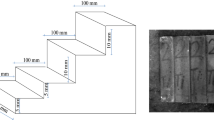Abstract
One of the most widely utilized NDT techniques for detecting subsurface discontinuities and material characterization is ultrasonic testing. The goal of this research is to see if ultrasonic technology can be used to examine the structure and qualities of nodular cast iron. For the trials, different amounts of alloys were added to the melt to obtain SG iron specimens with different nodularity percentages. The goal of research work is to generate the relationship between sound wave velocity with microstructural and mechanical properties of inspected casting samples of different grades with the help of ultrasonic technique. The ultrasonic technique can be used to evaluate percentage nodularity, hardness, and tensile strength. Ultrasonic procedures minimize the need for specimen preparation and destructive testing, and they can be completed in a matter of minutes at a low cost. As a result, the ultrasonic technique may be used to characterize casting materials and is an useful quality control tool.












Similar content being viewed by others
References
E.B. Howard and L.G. Timothy, Metals Handbook Desk Edition, vol. 1. (American Society for Metals, Russell Township, 1985).
L. Shen-Chih, and S. Jia-Ming, Ultrasonic nondestructive evaluation of matrix structures and nodularity in cast irons. Metal. Trans. A 20A, 2399–2407 (1989).
P.P. Nanekar and B.K. Shah, Characterization of materials properties by ultrasonics. BARC Newslett. 249, 25–38 (2004)
M. Nadeem Bhat, D.M. Afzal Khan and K.K. Singh, Effect of preconditioning and inoculation on graphite nodule count and their size distribution in spheroidal graphite (SG) cast iron: a study to minimise rejection of castings due to shrinkage porosity. Int. J. Metalcast. 13(1), 89–97 (2018). https://doi.org/10.1007/s40962-018-0230-7
S.A. Kamble, S.B. Rayjadhav and V.D. Shinde, Review paper on characterization of casting material by ultrasonic techniques. Int. J. Innov. Res. Sci. Technol. (IJIRST) 05(12), 21–24 (2019).
H. Li, R.D. Griffin and C.E. Bates, Gray iron property measurements using ultrasonic testing. AFS Trans. 122(05), 1–11 (2005)
F. Uzun and A. Bilge, Applications of ultrasonic waves in measurement of hardness of welded carbon steels. Defense Technol. 11, 255–261 (2015)
Acknowledgements
The Department of Science and Technology of India has financed this research as part of the SMART FOUNDRY 2020 initiative, with Reference Number DST/TSG/AMT/2015/332. The authors warmly acknowledge the financial support Granted by D.S.T., Government of India, as part of the SMART Foundry initiative.
Funding
The Department of Science and Technology of India has financed this research as part of the SMART FOUNDRY 2020 initiative, with reference number DST/TSG/AMT/2015/332.
Author information
Authors and Affiliations
Corresponding author
Ethics declarations
Conflict of interest
The purpose of the research is to establish a connection between sound wave velocity with microstructural and mechanical properties of inspected casting samples of different grades with the help of ultrasonic technique. The ultrasonic technique can be used to evaluate percentage nodularity, hardness, tensile strength, yield strength, and percentage elongation. As a result, the ultrasonic technique is a useful quality control tool for determining the properties of diverse casting materials.
Additional information
Publisher's Note
Springer Nature remains neutral with regard to jurisdictional claims in published maps and institutional affiliations.
Rights and permissions
About this article
Cite this article
Rayjadhav, S.B., Kamble, S.A. & Shinde, V.D. Characterization of SG Iron by Ultrasonic Techniques. J. Inst. Eng. India Ser. D 103, 107–116 (2022). https://doi.org/10.1007/s40033-021-00327-5
Received:
Accepted:
Published:
Issue Date:
DOI: https://doi.org/10.1007/s40033-021-00327-5




